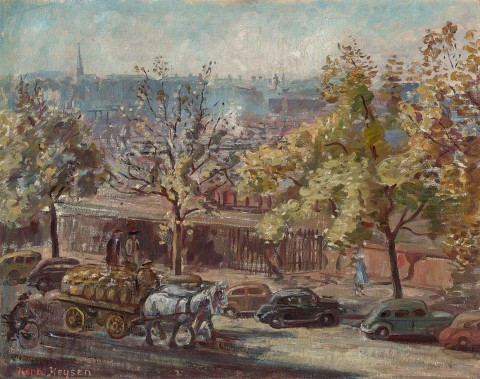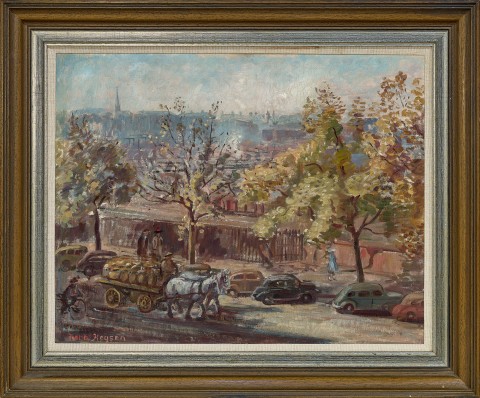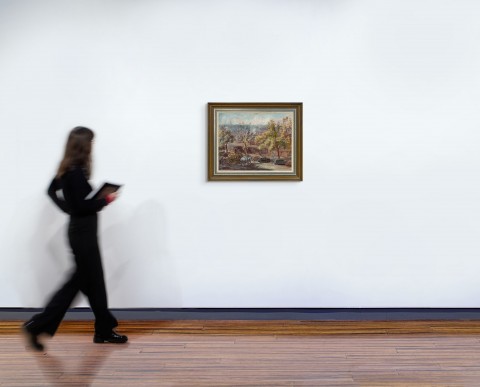(1911 - 2003)
Nora Heysen
Flinders Street Station, 1944
oil on canvas on plywood
Private collection, Adelaide
Private collection, Melbourne, a gift from the above, c.1992
Nora Heysen, S.H. Ervin Gallery, Sydney, 8 September – 15 October 1989, cat. 56
Nora Heysen, National Library of Australia, Canberra, 25 October 2000 – 28 January 2001
Klepac, L., Nora Heysen, Beagle Press, Sydney, 1989, cat. 56, pp. 56 (illus.), 79
Klepac, L., Nora Heysen, National Library of Australia, ACT, 2000, p. 51
Flinders Street Station no. 2, 1943 - 44 (dated 1946), oil on canvas on cardboard, 46.0 x 60.9 cm, National Gallery of Victoria, Melbourne
When Nora Heysen was awarded the 1938 Archibald Prize for her striking portrait Madame Elink Schuurman, she set a cat amongst the pigeons, that is, the local scions of the male-dominated art world who complained vociferously. Max Meldrum for one who wrote scathingly that an art career was ‘unnatural and impossible for a woman’1; whilst others claimed she was only treated favourably due to her father, the celebrated Hans Heysen. Of course, nothing was further than the truth and she triumphed again in 1943 when she became the first woman to accept an invitation from the Australian War Memorial to become an official war artist. She was eventually sent to New Guinea but in the interim, she spent some months in Melbourne from October 1943 to April 1944, where Flinders Street Station, 1944 (originally titled Melbourne street scene) was painted.
Heysen – or to give her official title, VFX 940085 Captain Heysen, N. AIF – was accommodated at the Menzies Hotel. Her first studio was with other war artists based at the Military History Headquarters on St Kilda Road, then in early 1944 she moved into a new space at 138 Flinders St, a building which had ‘lately been the morgue’,2 from which, she wrote in a letter, ‘the outlook is quite fascinating and I've started a canvas of the railway lines and trains.’3 She eventually did two versions of differing views from her window comprising this lot and its companion, the smaller and currently mis-dated Flinders Street Station No. 2, 1943 - 44 (dated 1946) (National Gallery of Victoria) which was also given its current title by the artist prior to its exhibition at the S.H. Ervin Gallery, Sydney, in 1989. However, the artist's studio was a good 250 metres from the Station and the paintings look to the opposite direction, following the curving rail lines towards Richmond.4 Visible on the skyline in each is the prominent spire of St Ignatius Church on Richmond Hill, a view which has been obliterated over time by skyscrapers and overgrown vegetation, as well as infrastructure such as the Batman Ave Bridge which now obscures the rail lines.
Initially studying at the North Adelaide School of Fine Art (with generous, low-key input from her father), Heysen was noted first for her extraordinarily precise portraits which presented an accuracy that recalled Vermeer. From 1934 to 1937, she studied in London where she befriended artist Lucien Pissarro’s daughter Orovida, who encouraged her to be livelier with her paint. Indeed, Flinders Street Station could be a magnified incident from a painting by Camille Pissarro, Orovida’s grandfather, whose bustling Boulevard Montmartre, morning, cloudy weather, 1897, was a star of the National Gallery of Victoria’s collection. Following Orovida’s suggestion, Heysen adopted a more painterly technique, as seen in her Archibald winning portrait and in the two Flinders Street views. In the work on offer here, the artist scrutinises the humble scene below her and features three modes of transport set against the vertical pattern made by the palings of the rail-concealing fencing, long since replaced by rusting cyclone wire and now cloaked in ivy.
1. ‘Art Prize to Woman. Marriage before career. Advice by artist’, The Herald, Melbourne, 21 January 1939, p. 8
2. See Nora Heysen, Letter to her parents 19 September 1944, transcribed in Speck, C. (ed.), Heysen to Heysen: selected letters of Nora Heysen and Hans Heysen, National Library of Australia, Canberra, 2011, p. 139. Notably, 138 Flinders Street is still standing, now absorbed within the neighbouring Duke of Wellington hotel redevelopment.
3. Nora Heysen, Letter to her parents, February/March 1944, see ibid. p. 140
ANDREW GAYNOR


